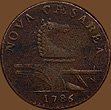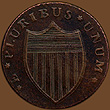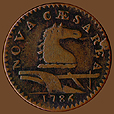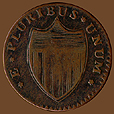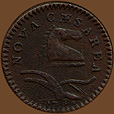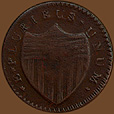New Jersey Coppers 1786-1790
obverse |
|
reverse |
| |||
1786 Maris 14-J Rahway 1787 Goadsby and Cox NJ Copper
Obverse: NOVA CÆSAREA 1786
Reverse: * E * PLURIBUS * UNUM *
Weight: 149.8 g (9.71 grams) Diameter: 27.8 mm Reverse die alignment: 170°
Comments: This is one of ten combinations using the reverse die J. Six of the obverse dies used with this reverse carry the date 1786 (obverses 13, 14, 15, 16, 17 and 18), while four (obverses 34, 35, 36 and 37) bear the date 1787. According to Hodder 14-J was the first reverse J combination to be minted in large quantities, attributed to the Rahway mint in 1787.
The obverse is one of the varieties with a straight rather than a curved beam on the plow. In this case it is longer than usual, extending close to the rim. It is easily distinguished from other straight (or curved) beam obverses used with the reverse J in that only in obverses 14 and 15 are the horse's ears aligned over the letter C. It can be distinguished from obverse 15 as it is the only straight beam obverse joined with reverse J in which both the start and end of the legend are distant from the plow (on obverse 15 the starting letter N is very close to the plow handle).
The reverse of New Jersey coppers are difficult to describe as there are few easily defined locations that can be measured to find their relative distance. The most obvious points of reference are the three points on the top of the shield, which on many varieties are aligned with the same letters of the legend and thus usually cannot assist is differentiating the varieties. The major distinguishing characteristic mentioned in discussions of New Jersey reverse dies is the style of the shield. These stylistic differences are difficult to accurately explain but are fairly evident when comparing examples of the different shield varieties. The reverse J is known as having a wide asymmetrical shield. It can be classified in the following subcategories: it is one of several varieties where the center point on the top of the shield is higher than the end points; also, the vertical lines on the shield, known as pales, are grouped in three (some varieties have groups of four).
The 14-J copper was probably minted in the early part of 1787, Hodder calls it the earliest of the J reverse varieties to be minted in quantity. It appears this example was struck rather late in the use of that die combination. Hodder has discussed a die clash that occurred after a majority of the 14-J was minted affecting the vertical stripe (pales) section of the shield. It appears on this example as a slightly darker area starting at the bottom of the far right set of stripes and moving diagonally upward to the top of the far left set of stripes. Soon thereafter a diebreak occurred from the shield moving diagonally down to the serif at the bottom of the final stroke of the M in UNUM. Although this was still early in the life of the reverse J, it was at the end of the minting of the 14-J variety. The present example appears to have been minted soon after the appearance of the second break for this break is noticeable as a small tick extending from the outline of the shield, a light line from the tick to the M is only visible when examining the coin at an angle. Apparently the obverse die did not hold up very well for Hodder mentions this obverse usually has a bulge, which is evidence the die was failing. In our example the obverse bulge area is visible as a diagonal line from the R in the legend down to the area of the date. Also note the die break at the date; it goes from the left of the 6 down through the center of the 8 and continues through the 7. Heavier areas of the break show up better on the scan than the hairline areas.
Provenance: From the Robert H. Gore, Jr. Numismatic Collection.
obverse |
|
reverse |
| |||
1786 Maris 16-L Elizabethtown 1788 Matthais Ogden "Protruding tongue" variety NJ Copper
Obverse: NOVA CÆSAREA 1786
Reverse: * E * PLURIBUS * UNUM *
Weight: 133.6 g (8.66 grams) Diameter: 27.99 mm Reverse die alignment: 160°
Comments: Obverse 16 can be distinguished by the straight beam on the plow that turns up at the end; also the initial N and final A in the legend are close to the plow. The horse also has a long nose. A die break developed from the mouth of the horse toward the R in the legend giving the appearance of a "protruding tongue." Later a large break developed at the rim between the R and E. Also note, on this example, the final top serif of the N in NOVA is absent. Obverse 16 was joined with reverses J, d (rare), S (unique), and L, in that order. Hodder suggests 16-J was the first combination minted, starting in 1787, followed by d and S. These coins were followed by the 16-L combination. It appears early in the minting of this coin the rim die break appeared, as most examples display the break. At this time reverse J was used once again, as about a third of that issue show the die break, and some examples of reverse d appear to date to the later period of 1788-1790. Hodder suggests Reverse L dates to the third phase of New Jersey coppers, after June of 1788 by Matthais Ogden in Elizabethtown.
On reverse L the shield is rather wide with the top middle point closer to the dexter point, which is the point to the viewer's left. The vertical lines on the shield, known as pales, are grouped in three (some varieties have groups of four). This reverse was combined with three obverses dated to 1786, obverses: 15, 16 and rarely with obverse 18 as well as with four reverses dated to 1787, reverses: 28, 29, 30, 31. In his article on Reverse U, Hodder suggested all examples of Maris 15-L date to the third phase of New Jersey coppers, after June of 1788 by Matthais Ogden in Elizabethtown. Although an emission sequence has not been published for reverse L is seems likely 16-L dates from that same period, especially as the joining of obverse 16 (displaying the rim die break) and reverse L is at the end of the obverse 16 die emission.
Provenance: Acquired through the Robert H. Gore, Jr. Numismatic Endowment from the EAHA auction of October 10, 1998, lot 634.
obverse |
|
reverse |
| |||
1786 Maris 18-M Rahway 1787 Goadsby and Cox "Bridle" variety NJ Copper
Obverse: NOVA CÆSAREA 1786
Reverse: * E * PLURIBUS * UNUM *
Weight: 138.2 g (8.95 grams) Diameter: 28.6 mm Reverse die alignment: 180°
Comments: Obverse die 18 is most notable for a die scratch producing a line from the end of the horse's nose down to his neck, called a "bridle" by collectors. This obverse is also distinctive in that the horse is far to the right, very close to the legend. Also, the plow beam has a pronounced curve and the thick diagonally running coulter almost touches the thin singletree. This variety also has a high rim and pronounced denticles. Obverse 18 was joined with reverses M, J, L, and N, in that order. Some examples of 18-M exist which predate the die damage and thus are without the "bridle," while all other combinations show the fully developed "bridle." This indicates 18-M was the earliest in the various combinations. Hodder suggests most of the 18-J coppers date to 1787-88. As the 18-J was minted after the 18-M we can assume the 18-M was minted at Rahway no later than 1787.
Reverse M has a very wide shield. It can be distinguished from reverse N, the only other wide shield joined with obverse 18, in that the middle point on the shield of reverse M is aligned with the first vertical stroke of the second letter U in PLURIBUS (on reverse N the middle point is aligned just before the final S). The vertical lines on the shield, known as pales, are grouped in four (some varieties have groups of three). Although not seen on this example at some later point a die break appeared joining the U an M in UNUM. In this example the reverse legend shows some die movement during minting producing a doubling effect. This doubling is not due to a recutting of the die for it is not found on other examples. Also, note the denticles from 3:00 to 6:00 o'clock are much smaller and thinner than the rest. The denticles were added to the die with a tool that looked like a small "branding iron" in the shape of a quarter circle. Using a hammer the diecutter would impress the denticle image on one quarter of the rim of the die at a time. This shows that more than one tool was used on the die.
Provenance: From the Robert H. Gore, Jr. Numismatic Collection.
| Connecticut Coppers: p. 4 | Section Contents | New Jersey Coppers: p. 2 |
|
For viewing tips and information on optimal computer settings click
here.
For questions or comments contact Special Collections by: |
